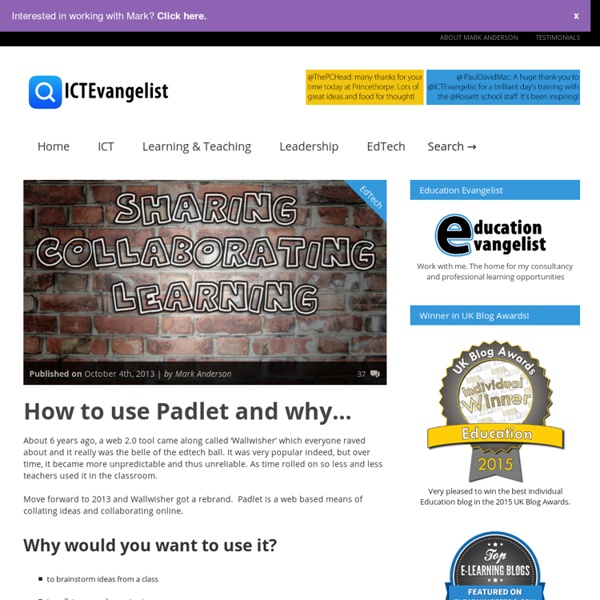Socrative Student Response System
My name is Dennis Villano and I am the Director of Technology Integration for Burlington (MA) Public Schools. Thank you to Richard for this great opportunity to guest post about the Socrative student response system. Socrative is a rapidly evolving free web application that provides the easiest and most user-friendly experience I've seen from any student response system. Socrative will ultimately provide full-featured apps for iOS and Android devices. Socrative provides a similar end user experience to that of the SMART Response System or Promethean Activote. Teachers can register for a free account. The system is appropriate for almost any grade level.
Padlet: Engage and Get Them Thinking
One of my favorite tools for student engagement and discussion is Padlet (formerly Wallwisher). I am such a big fan that I wrote about Wallwisher for SchoolArts a few years ago and presented on the renamed Padlet at the AOE Conference in January. What I love most about Padlet is the ability for ALL students to “speak” simultaneously in an open forum discussing art concepts at a higher level. Here is an example of one of my classes using Padlet. Padlet as an Exit Slip Thanks to my PLN on Twitter I discovered how middle school teacher Sarah Irish uses Padlet with a custom background as a way to check in on a specific topic or just see how things are going with her classes. Collaborate anywhere with Padlet! Thank you to the great art teachers on Facebook who weighed in on the recent decision of tallest skyscraper in America. Set up a Padlet Wall in 3 minutes or less! What do you think?
60 Ways To Use Twitter In The Classroom By Category
Social media offers some great opportunities for learning in the classroom, bringing together the ability to collaborate, access worldwide resources, and find new and interesting ways to communicate in one easily accessible place. Teachers around the world have found innovative ways to use Twitter as a teaching tool (including TeachThought’s favorite), and we’ve shared many of these great ideas here with you. Read on, and we’ll explore 60 inspiring ways that teachers and students can put Twitter to work in the classroom. Communication Twitter makes staying in touch and sharing announcements super simple and even fun. Organization Twitter’s hashtags and other tools share a great way to organize information for your classroom. Resources Use these ideas to take advantage of the vast resources that Twitter has to offer. Writing Skills
The Flipped Classroom: Tips for Integrating Moments of Reflection
February 17, 2014 By: Barbi Honeycutt, PhD and Sarah Egan Warren in Instructional Design “Students in inverted classrooms need to have more space to reflect on their learning activities so that they can make necessary connections to course content” (Strayer, 2012). If you were to observe a flipped classroom, what do you think would it look like? Maybe students are working in groups. Maybe each group is working on a different problem. The flipped classroom is a busy, collaborative, and social place. But what does this mean for students who don’t excel in this collaborative space? In the flipped classroom, the instructor’s challenge is to design learning experiences that engage students in higher level thinking and problem solving during the class time. But, are we missing a whole segment of our student population and minimizing the importance of reflective engagement in favor of active engagement by only defining the flip in terms of collaborative learning? So, what can we do? Monahan, N.
9 Characteristics Of 21st Century Learning
The label of “21st Century learning” is vague, and is an idea that we here at TeachThought like to take a swing at as often as possible, including: –weighing the magic of technology with its incredible cost and complexity –underscoring the potential for well thought-out instructional design –considering the considerable potential of social media platforms against its apparent divergence from academic learning Some educators seek out the ideal of a 21st century learning environment constantly, while others prefer that we lose the phrase altogether, insisting that learning hasn’t changed, and good learning looks the same whether it’s the 12th or 21st century. At TeachThought, we tend towards the tech-infused model, but do spend time exploring the limits and challenges of technology, the impact of rapid technology change, and carefully considering important questions before diving in head-first. The size of the circles on the map are intended to convey priority. 1. 2. 3. 4. 5. 6. 7. 8. 9.
5 Ways To Use Video Collaboration For Effective Learning
In today’s connected world, students are increasingly comfortable using video to communicate in their personal lives. From using Facetime to keep in contact with families at home to connecting via Google Hangout with friends studying abroad, students are coming into the classroom with a rich skill set of video collaboration methods, often without knowing it. Video has become second-nature to so many students. For effective learning, incorporating real-time video is increasingly important and can truly enhance student outcomes. Designing video into traditional, online, and hybrid classes is surprisingly easy: Add Video Online Most students now have the capability to participate in an online video session. Make Video Part of A Hybrid Course As an example, Lafayette College has been implementing video conferencing as the online portion of a hybrid creative writing class. Bring In Experts Schedule Small Group Time Small groups are an essential part of most classes. Handle Housekeeping Issues
NSDL.org - National Science Digital Library



